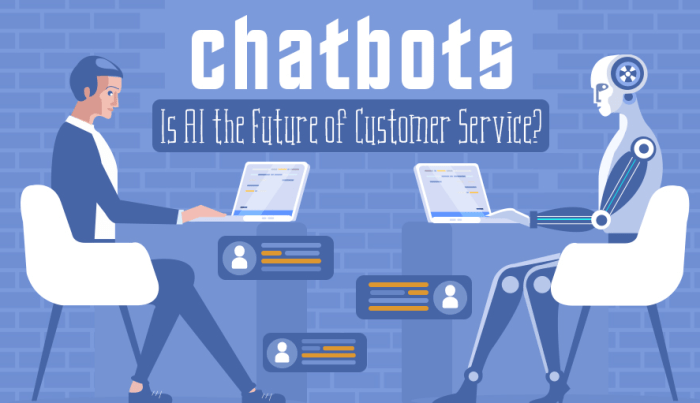Overview of AI Chatbots in Customer Service
The Rise of AI Chatbots: Transforming Customer Service – Artificial intelligence (AI) chatbots are computer programs that simulate human conversation through text or voice interactions. They are designed to provide automated customer service, answering queries, resolving issues, and offering assistance.
AI chatbots are increasingly adopted in customer service due to their ability to provide 24/7 support, handle high volumes of inquiries, and improve customer satisfaction. They are particularly effective in resolving common issues, freeing up human agents to focus on more complex tasks.
Examples of Successful AI Chatbot Implementations
- Amazon Alexa:A voice-activated AI chatbot that provides information, plays music, controls smart home devices, and more.
- Google Assistant:A conversational AI chatbot that can answer questions, set reminders, make appointments, and control other devices.
- IBM Watson Assistant:An AI chatbot that can understand natural language, answer questions, and provide recommendations.
Benefits of AI Chatbots for Customer Service
The integration of AI chatbots in customer service has revolutionized the way businesses interact with their customers. These chatbots offer numerous advantages that enhance customer experience, optimize costs, and streamline operations.
Improved Customer Experience
- 24/7 Availability:AI chatbots are available round-the-clock, providing immediate assistance to customers regardless of time or location.
- Personalized Interactions:Chatbots can analyze customer data and preferences to tailor responses, creating personalized experiences.
- Instant Responses:Unlike human agents, AI chatbots respond instantly, eliminating wait times and frustration.
Cost Savings and Efficiency Gains
- Reduced Labor Costs:AI chatbots automate routine tasks, freeing up human agents to focus on more complex issues.
- Increased Efficiency:Chatbots can handle multiple customer inquiries simultaneously, increasing overall efficiency.
- Reduced Training Costs:Chatbots require minimal training compared to human agents, reducing onboarding costs.
Ability to Handle Multiple Inquiries Simultaneously
- Scalability:AI chatbots can be scaled up or down to meet fluctuating customer demand.
- Multi-Channel Support:Chatbots can be deployed across multiple channels, including websites, messaging apps, and social media.
- Increased Customer Satisfaction:By providing quick and efficient support, AI chatbots enhance customer satisfaction and loyalty.
Challenges of Implementing AI Chatbots
Integrating AI chatbots into customer service operations poses several challenges that organizations must address to ensure successful implementation.
Technical Difficulties
Technical complexities can arise during the implementation of AI chatbots. These include:
- Data integration:Connecting AI chatbots with existing customer relationship management (CRM) systems and other data sources can be challenging, especially if the data is unstructured or incompatible.
- Natural language processing (NLP) limitations:AI chatbots rely on NLP to understand and respond to customer inquiries. However, NLP models can struggle with complex or ambiguous language, leading to errors or unsatisfactory responses.
- Scalability:As the number of customer interactions increases, AI chatbots must be able to handle the volume without compromising performance or response times.
Training and Maintenance
Proper training and ongoing maintenance are crucial for AI chatbots to deliver effective customer service. This involves:
- Initial training:AI chatbots require comprehensive training on relevant knowledge bases and customer interaction scenarios to ensure accurate and helpful responses.
- Continuous learning:AI chatbots should be continuously updated with new data and feedback to improve their understanding and response capabilities.
- Monitoring and evaluation:Regular monitoring and evaluation are essential to identify areas for improvement, address errors, and ensure the chatbot is meeting customer expectations.
Job Displacement Concerns
The implementation of AI chatbots has raised concerns about potential job displacement. However, it is important to note that:
- Task automation:AI chatbots primarily automate repetitive and routine tasks, allowing human customer service representatives to focus on more complex and value-added interactions.
- Skill enhancement:AI chatbots can enhance the skills of human representatives by providing them with real-time data and insights, enabling them to deliver more personalized and efficient service.
- New job opportunities:The development, deployment, and maintenance of AI chatbots create new job opportunities in fields such as data science, machine learning, and chatbot engineering.
Best Practices for Implementing AI Chatbots

Implementing AI chatbots effectively requires careful planning and execution. Here’s a step-by-step guide to help you achieve success:
1. Define your goals and objectives: Determine the specific objectives you want to achieve with AI chatbots, such as improving customer satisfaction, reducing wait times, or generating leads. Clearly defined goals will help you measure the effectiveness of your chatbot implementation.
2. Choose the right chatbot platform: Select a chatbot platform that aligns with your technical capabilities, budget, and specific requirements. Consider factors such as ease of use, customization options, and integrations with your existing systems.
3. Design and develop your chatbot: Create a chatbot that is user-friendly, informative, and engaging. Use natural language processing (NLP) to enable the chatbot to understand and respond to customer inquiries in a conversational manner.
4. Train and test your chatbot: Train your chatbot on a comprehensive dataset to ensure accurate and efficient responses. Conduct thorough testing to identify and resolve any potential issues before deploying the chatbot.
5. Monitor and optimize your chatbot: Regularly monitor the performance of your chatbot and make adjustments as needed. Track metrics such as response time, customer satisfaction, and conversion rates to identify areas for improvement.
Tips for Optimizing AI Chatbot Performance
- Use a conversational tone that is friendly and approachable.
- Provide clear and concise responses that address the customer’s inquiry directly.
- Use NLP to understand the context of customer inquiries and provide relevant responses.
- Offer personalized experiences by tailoring responses based on customer data.
- Continuously train and update your chatbot with new data to improve its accuracy and performance.
Strategies for Integrating AI Chatbots with Existing Customer Service Channels
Integrate your AI chatbot with your existing customer service channels, such as live chat, email, and social media, to provide a seamless and consistent customer experience. Consider the following strategies:
- Use AI chatbots to handle initial customer inquiries, freeing up human agents for more complex tasks.
- Enable customers to seamlessly transition between AI chatbots and human agents as needed.
- Provide customers with the option to choose between interacting with an AI chatbot or a human agent.
- Use AI chatbots to gather customer feedback and improve the overall customer experience.
Future Trends in AI Chatbots

The future of AI chatbots is bright, with many emerging technologies poised to shape their development and impact on customer service.
One key trend is the integration of AI chatbots with other technologies, such as natural language processing (NLP) and machine learning (ML). This will allow chatbots to better understand customer intent and provide more personalized and relevant responses.
NLP and ML Integration
NLP and ML enable chatbots to analyze and interpret human language more accurately. This leads to improved understanding of customer queries and the ability to generate more natural and contextually appropriate responses.
Conversational AI
Conversational AI involves chatbots that can engage in natural and engaging conversations with customers. This technology leverages advanced NLP and ML algorithms to understand customer intent, generate personalized responses, and maintain context throughout the conversation.
Omnichannel Integration
AI chatbots are becoming increasingly integrated with multiple communication channels, such as websites, messaging apps, and social media. This allows customers to interact with chatbots seamlessly across different platforms, providing a consistent and convenient experience.
Ethical Considerations
As AI chatbots become more sophisticated, it is crucial to consider the ethical implications of their use.
Data Privacy and Security
AI chatbots collect and process large amounts of customer data, raising concerns about data privacy and security. It is essential to ensure that chatbots are designed with robust security measures and that customer data is handled responsibly.
Bias and Fairness
AI chatbots can inherit biases from the data they are trained on, leading to unfair or discriminatory outcomes. It is important to address these biases and ensure that chatbots are designed to be fair and impartial.
Transparency and Accountability, The Rise of AI Chatbots: Transforming Customer Service
Customers should be aware that they are interacting with an AI chatbot. Transparency about the chatbot’s capabilities and limitations is crucial for building trust and ensuring that customers can make informed decisions about their interactions.
Questions Often Asked: The Rise Of AI Chatbots: Transforming Customer Service
What are the key benefits of AI chatbots in customer service?
AI chatbots offer numerous benefits, including improved customer experience, reduced costs, increased efficiency, and the ability to handle multiple inquiries simultaneously.
What are the challenges associated with implementing AI chatbots?
Implementing AI chatbots can involve technical difficulties, require ongoing training and maintenance, and raise concerns about potential job displacement.
How can businesses effectively implement AI chatbots?
Effective implementation involves a step-by-step approach, optimizing chatbot performance, and integrating them with existing customer service channels.
